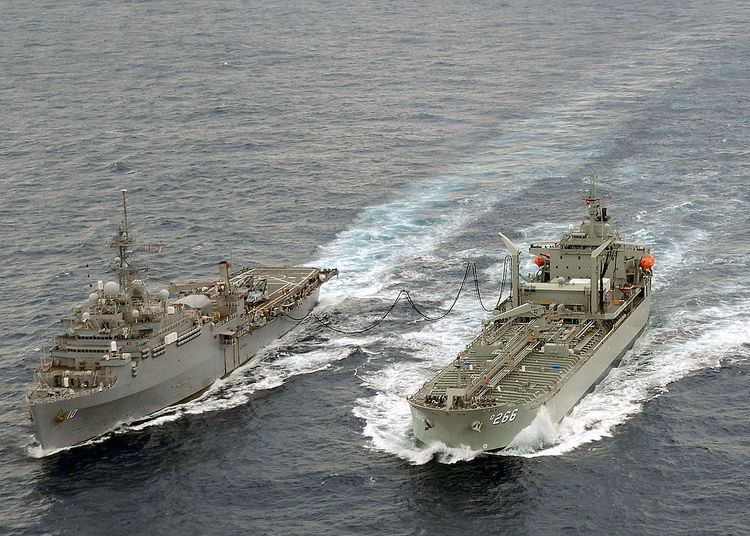 | ||
A replenishment oiler is a naval auxiliary ship with fuel tanks and dry cargo holds, which can conduct underway replenishment on the high seas. Several countries have used replenishment oilers.
Contents
The US Navy hull classification symbol for this type of ship was AOR. Replenishment oilers are slower and carry fewer dry stores than the US Navy's fast combat support ships (AOEs).
History
The development of the 'oiler' paralleled the change from coal- to oil-fired boilers in warships. Prior to the adoption of oil fired machinery, navies could extend the range of their ships either by maintaining coaling stations or for warships to raft together with colliers and for coal to be manhandled aboard. Though arguments related to fuel security were made against such a change, the ease with which liquid fuel could be transferred led in part to its adoption by navies worldwide.
One of the first generation of 'blue-water' navy oiler support vessels was the British RFA Kharki, active 1911 in the run-up to the First World War. Such vessels heralded the transition from coal to oil as the fuel of warships and removed the need to rely on, and operate within range of, 'coaling stations'.
Modern examples of the fast combat support ship include the large British Fort-Class, displacing (31,066 long tons) and 669 ft in length, and the Australian HMAS Sirius.
Characteristics
For smaller navies, such as the Royal New Zealand Navy, replenishment oilers are typically one of the largest ships in the navy. Such ships are designed to carry large amounts of fuel and dry stores for the support of naval operations far away from port. Replenishment oilers are also equipped with more extensive medical and dental facilities than smaller ships can provide.
Such ships are equipped with multiple refueling gantries to refuel and resupply multiple ships at a time. The process of refueling and supplying ships at sea is called underway replenishment. Furthermore, such ships often are designed with helicopter decks and hangars. This allows the operation of rotary-wing aircraft, which allows the resupply of ships by helicopter. This process is called vertical replenishment. Furthermore, such ships, when operating in concert with surface groups, can act as the aviation maintenance platform where helicopters receive more extensive maintenance than can be provided by the smaller hangars of the escorting ships.
Their size, additional facilities, and ability to support the operation of other vessels, means that replenishment oilers have been used as command ships, with some ships, such as the French Durance-class, this capability being built into the vessels from the start.
Armament
Because the replenishment oiler is not a combat unit, but rather a support vessel, such ships are often lightly armed, usually with self-defense systems (such as the Phalanx CIWS close-in weapons systems), small arms, machine guns and/or light automatic cannons. They may also carry man-portable air-defense systems for additional air defense capability.
Examples
Replenishment oilers include:
The Canadian Navy (Joint Support Ship Project) and the Spanish Navy are actively designing and building replenishment oilers.
